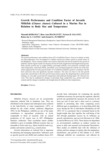The growth performance and condition factor (CF) of milkfish (Chanos chanos) in relation to body size and temperature were investigated in a shallow marine pen culture system in coastal waters of the Philippines. Three common models were tested to determine the best-fit model for the growth of milkfish, and the logistic model was found to be best for both weight-based and length-based growth. Daily specific growth rate in weight (DSGRw) and length (DSGRL) were positively correlated with water temperature, while both DSGRw and DSGRL were correlated negatively with the size of the fish, which supported the fit of the growth model. CF of milkfish exhibited a positive correlation with the feed conversion ratio and significant seasonal variations. The ratio was lower in the fast growth season (dry season) than in the slow growth season (rainy season). By integrating these controversial findings, we were able to posit that low temperature and inefficient feeding makes ‘fat’ fish and vice versa. This may be explained by changes in proximate body composition (e.g., protein and water content) and the change in metabolic rate brought about by different water temperatures.

